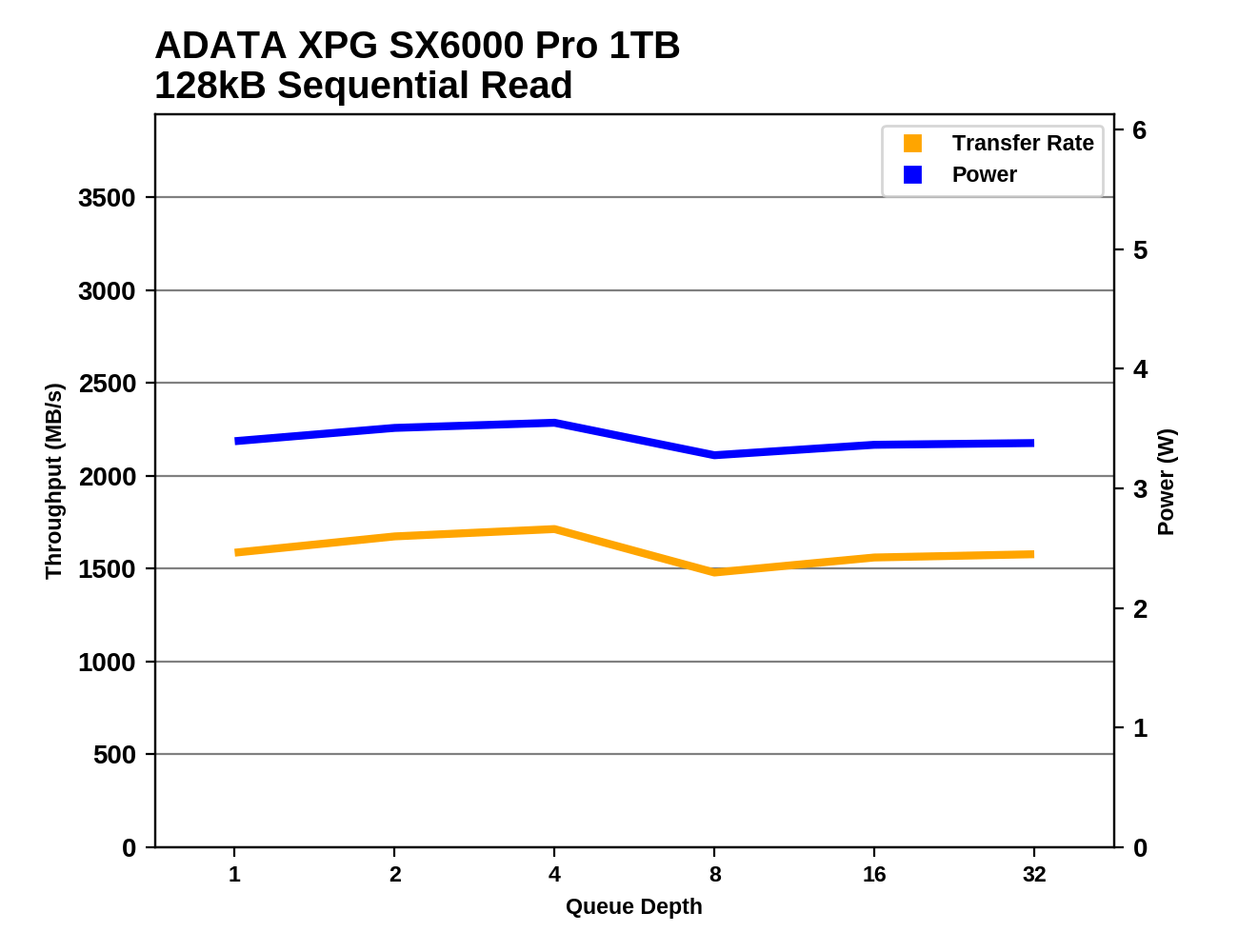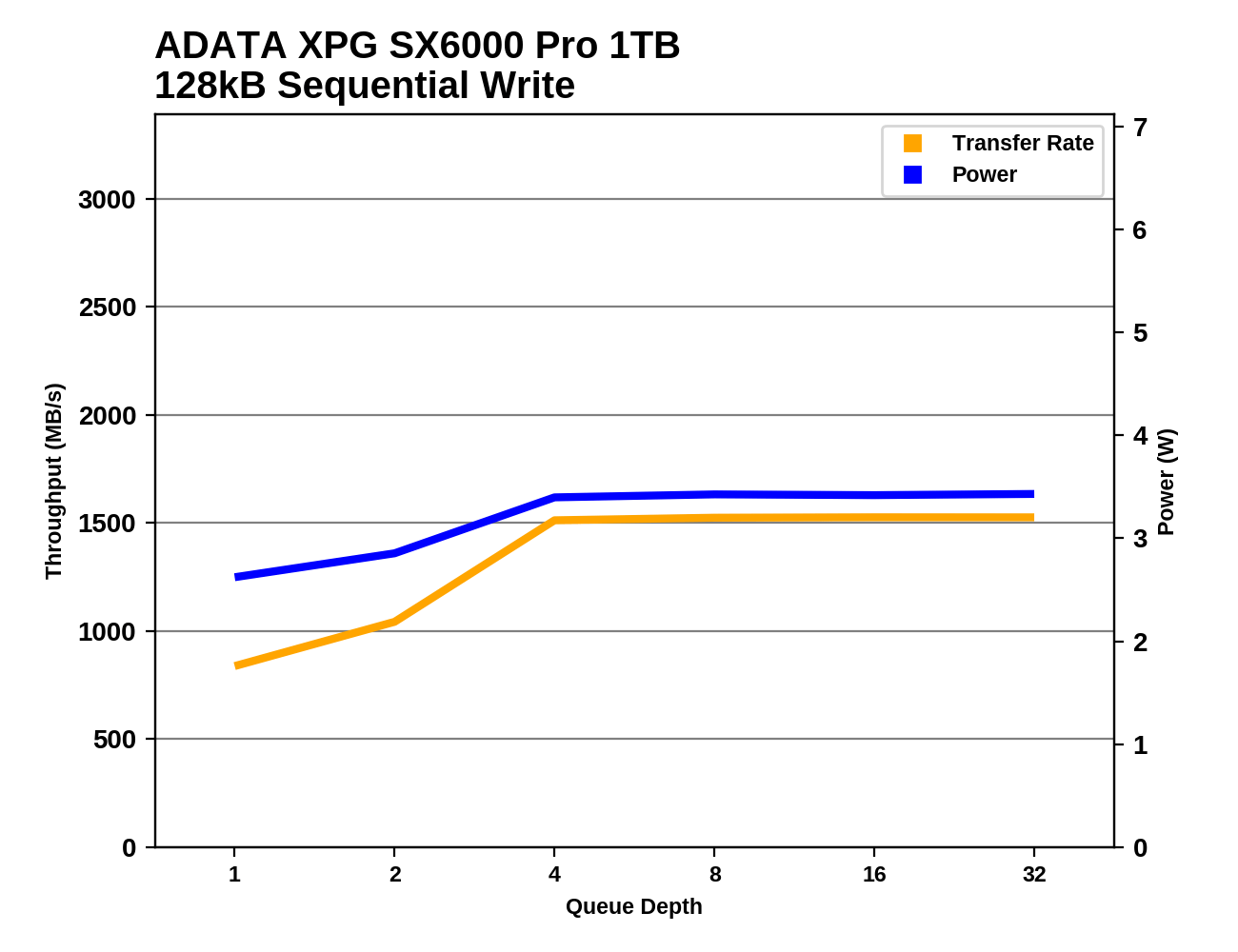The ADATA XPG SX6000 Pro 1TB SSD Review: Realtek's Entry-level NVMe Solution
by Billy Tallis on December 18, 2019 12:30 PM ESTSequential Read Performance
Our first test of sequential read performance uses short bursts of 128MB, issued as 128kB operations with no queuing. The test averages performance across eight bursts for a total of 1GB of data transferred from a drive containing 16GB of data. Between each burst the drive is given enough idle time to keep the overall duty cycle at 20%.

The burst sequential read performance of the ADATA XPG SX6000 Pro is comparable to other entry-level NVMe drives and some of the underperforming high-end drives. It is about three times the performance of SATA SSDs, and just over half the performance of the fastest high-end drives in this batch.
Our test of sustained sequential reads uses queue depths from 1 to 32, with the performance and power scores computed as the average of QD1, QD2 and QD4. Each queue depth is tested for up to one minute or 32GB transferred, from a drive containing 64GB of data. This test is run twice: once with the drive prepared by sequentially writing the test data, and again after the random write test has mixed things up, causing fragmentation inside the SSD that isn't visible to the OS. These two scores represent the two extremes of how the drive would perform under real-world usage, where wear leveling and modifications to some existing data will create some internal fragmentation that degrades performance, but usually not to the extent shown here.

On the longer sequential read test, the SX6000 Pro maintains its good standing. It's not in the top tier of high-end drives, but it is in the second tier that includes some high-end 8-channel+DRAM drives.
 |
|||||||||
| Power Efficiency in MB/s/W | Average Power in W | ||||||||
As usual, the power efficiency of the SX6000 Pro is poor, but for sequential reads it isn't the worst-scoring NVMe drive and it isn't too far below average.
 |
|||||||||
The sequential read performance of the SX6000 Pro dipped at QD8 and didn't fully recover before the end of the test, so even at high queue depths it doesn't attain the rated 2.1GB/s and instead is stuck closer to 1.5GB/s. The Mushkin Helix-L also showed a slight performance dip during the second half of the test, but it recovered and had no further trouble maintaining full speed.
Graphed against the whole database of results, the SX6000's power efficiency seems fairly middle of the road. The performance could have been achieved with a PCIe 3 x2 connection, but that's still pretty much par for entry level NVMe drives.
Sequential Write Performance
Our test of sequential write burst performance is structured identically to the sequential read burst performance test save for the direction of the data transfer. Each burst writes 128MB as 128kB operations issued at QD1, for a total of 1GB of data written to a drive containing 16GB of data.

The SX6000 Pro is by far the slowest NVMe drive on the burst sequential write test, only managing 1GB/s compared to 1.6GB/s or more for other entry-level NVMe drives.
Our test of sustained sequential writes is structured identically to our sustained sequential read test, save for the direction of the data transfers. Queue depths range from 1 to 32 and each queue depth is tested for up to one minute or 32GB, followed by up to one minute of idle time for the drive to cool off and perform garbage collection. The test is confined to a 64GB span of the drive.

On the longer sequential write test that also includes some higher queue depths, the SX6000 Pro's score improves slightly, while the other low-end NVMe drives slow down a bit due to the higher volume of writes in this test. There's still a substantial gap between the SX6000 Pro and the rest of the NVMe drives, but it's much smaller than the SX6000 Pro's lead over SATA SSDs.
 |
|||||||||
| Power Efficiency in MB/s/W | Average Power in W | ||||||||
The SX6000 Pro is tied for worst power efficiency among these NVMe SSDs, but it's still providing twice the performance per Watt of a SATA drive. The other two DRAMless NVMe drives take the top two spots for power efficiency on this test.
 |
|||||||||
The SX6000 Pro doesn't hit its full sequential write speed until QD4, while the Mushkin Helix-L and Toshiba BG4 both saturate at QD2, and the BG4 has a clear speed advantage at full speed. The ADATA SU750 didn't manage to reach full speed until QD8, so clearly Realtek's NVMe controller has some advantages over their SATA controller.
As with sequential reads, the power efficiency of the SX6000 Pro doesn't look too bad when graphed against our entire library of SSDs, but there's definitely room for improvement. At high enough queue depths, the performance gets up to near the same levels that most entry-level or outdated high-end NVMe drives offer, and the drives that are substantially faster are mostly high-end models from the past one or two generations.












36 Comments
View All Comments
otonieru - Sunday, May 10, 2020 - link
Well, there's this scenario where in some region in the world, HP ssd is simply nonexistent in market, and when they do, the price is wayy higher compared to original price. So... ?rocky12345 - Wednesday, December 18, 2019 - link
So basically if you just want more ssd storage that is more cost effective then go for one of these dram less drives. If you care about performance and don't mind a bit of a extra cost then pick up a drive with a decent dram cache.My own personal wants/needs require a drive with a DRAM cache and any of these drives with the realtek chipset and any other one with no dram cache support is a huge no go for me.
NewMaxx - Wednesday, December 18, 2019 - link
Thank you for the review.Some reviewers have speculated that these newer Realtek controllers are using MLC rather than SLC mode. Your results to some degree support this conjecture. I personally did not expect to see that on a TLC drive, but what are your thoughts on the subject?
NewMaxx - Wednesday, December 18, 2019 - link
I'd like to add that I'm not supporting that viewpoint - full-drive SLC is in-line with ADATA's design principles on drives like this and the SU750 - but I'm curious about your take on those other reviews.Billy Tallis - Thursday, December 19, 2019 - link
The official spec sheet from ADATA says SLC caching, but I doubt those are actually written by people who would know better if it was MLC caching. The MLC caching hypothesis definitely explains why the cache is slower than usual for an SLC cache, and probably also why the folding process seems to be so slow. I'm not sure if it explains why the full-drive ATSB runs do comparatively well, and I'm still puzzled about the apparent lack of effect from HMB.NewMaxx - Friday, December 20, 2019 - link
Thank you for the reply. It'll be interesting to compare this to the RTS5762 drives.TheWereCat - Thursday, December 19, 2019 - link
It's only 10€ cheaper than SX8200 Pro where I live.127€ vs 137€ for 1TB.
LMonty - Thursday, December 19, 2019 - link
Good thing I saw this review before buying one for my laptop! Battery life would have been impacted.The_Assimilator - Thursday, December 19, 2019 - link
Simple maxim in the PC space: if you see "Realtek", avoid.crimson117 - Thursday, December 19, 2019 - link
Good luck buying a motherboard.